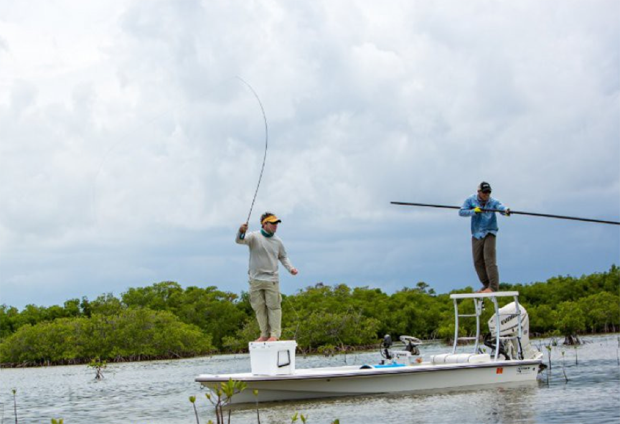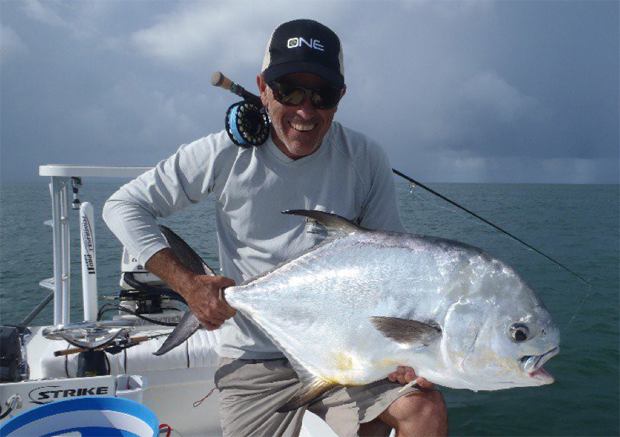Bonefish & Tarpon Trust’s Conservation Captain of the Month is Capt. Martin Carranza / September 2015
For more about Capt. Martin Carranza . . .
The interview:
Bonefish & Tarpon Trust: Where do you guide and how long have you been guiding for?
Martin Carranza: Biscayne Bay, Everglades National park and Upper Keys 9 months of the year. I also guide hosted trips at my lodge in Patagonia.
BTT: How did you become a fishing guide?
MC: When I realized how glamorous, profitable and glorious it was. Seriously, I’ve been fly fishing since I was 5 or 6 years old, fishing with my Dad, Grandpa and my little brother. When I was in my 20’s I moved to Patagonia so I could fish and guided on the weekends to make extra money to build my house. Then in 2001 I moved to Miami, Florida and fell in love with Biscayne Bay and it’s bonefish and decided to spend as much time as I could with them so I learned how to catch them and now I help others catch these fantastic game fish.
BTT: How many days per year do you guide?
MC: 180 days being in the water and the rest of the year booking trips for the lodges I represent as a booking agent

Capt. Martin Carranza and client seem to be on the same page. That’s a beautiful thing. Capt. Martin Carranza photo.
BTT: What species do most of your clients want to fish for. Why?
MC: I have a diverse clientele but most of them want to catch Tarpon, permit and bonefish in that order.
BTT: Tell us about how the fishery used to be, compared to today. (Numbers of fish caught, seen, number of anglers on the water, etc.)
MC: I can only tell you how it used to be since the early 2000’s until now, so my history here is short compared to some B&R anglers. In my humble experience I have seen the fishery improve a lot, especially these past two years. I am sure you guys will have the right answer as why this is happening, especially with bonefish. When started fishing here I saw larger bonefish in schools or singles, depending of the time of the year, these fish were difficult to catch on a fly unless you did a great presentation. After the freeze in 2010 bonefishing was difficult to say the least. It took me a while to find them in their usual places and didn’t see as many as before and in 2013 I have seen a progressive increase in small bonefish numbers (16” to 22”) in most of Biscayne Bay, from Stiltsville to Key Largo. These smaller fish are easier to feed than the larger, older fish, especially with flies which is my method of choice. I am also seeing a lot more permit to the point where I am not sure if I need to go to Mexico anymore to catch them.
BTT: In your opinion, what is the most important conservation issue facing the Keys fishery right now and what can be done to help fix it?
MC: I can only speak about the areas where I fish and think that the lack of controls in the water on behalf of the authorities is one, I believe people take more than they are allowed to. Water pollution is of huge impact and it’s all over the news. Habitat destruction is happening. So to answer this question I would implement better controls of recreational anglers, I would somehow create pole and troll areas, like in Everglades National Park and try to restore the natural flow of the river of Grass.
BTT: Despite some of the negative things happening to our fishery, why do you love it so much?
MC: I love it here because it is my home. It is challenging yet rewarding and it is a wonder of nature that in a place where men has done everything to ruin it we still have world record bonefish, tarpon, permit and other species.
BTT: Why do you support Bonefish and Tarpon Trust?
MC: Because BTT is an active organization trying with limited resources to succeed in balancing nature and preserve and protect our beloved species. BTT DOES THINGS and these things WORK.
BTT: In your opinion, what is the most important work that BTT does and why?
MC: The most important thing to me is that it was actually created AND it works. BTT is actively researching and finding answers that nobody knew, as an example that bonefish migrate from Biscayne Bay to the Bahamas and maybe Cuba…. Same with Tarpon. Knowledge is the key to conservation and all the work you guys are doing is paying its dividends in the form of more fish where they used to be.
BTT: Why should a fisherman that doesn’t live in Florida or the Caribbean care about BTT?
MC: This world is a delicate balance of nature, every living creature is linked to another despite the distance. We must preserve this balance. On a personal and selfish point of view if I was an angler living in say, Michigan and wanted to catch bonefish and tarpon, I should definitely care about our country’s own population of these fish.
BTT: You have the day off. What species are you going to fish for, where are you going to find them, and how are you going to catch them.
MC: I would go a few flats I know in between Key Biscayne and Key Largo where at either end of the low tide I will find double digit bonefish tailing or cruising with their fins off the water. I will be using a 6 wt rod with 14 + leader tapered to 12 lbs and my own boner fly. There are just 3 spots I know of where I can do this and most of the times I fail at feeding these huge bonefih, but that’s exactly what keeps me coming back.
BTT: Tell us one of your favorite fishing stories.
MC: Well, I remember that day clearly even though it happened 35 years ago. I was fishing the Malleo River with my Dad, one of the first Argentine fly fishers. It was raining hard and I was fishing a few yards behind him. I think I was 7 years old. I was fishing a fly called Matona, an old school streamer when I hooked a very big rainbow trout. I remember when I saw the flash underwater I thought I hooked a can and asked my Dad to help me unhook it. He started laughing when the “can” started jumping on the far bank and when I saw the size I panicked. It was a 10 lb silver rainbow trout and with the help of my Dad it took me a long while to land it. I was proud to see my Dad telling me all sort of compliments and loved every minute of that horrible rainy day. The photo of me and that trout was under the glass of my Grandpa’s night table. Of course there were no C&R ethics back then so we ate it. Oops.
Featured Image of Permit credit Capt. Martin Carranza.
Join Bonefish & Tarpon Trust and get to know the flats better . . .


